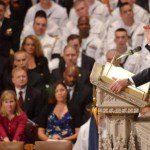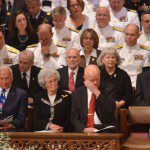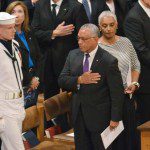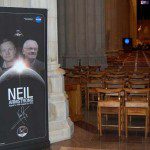America’s Hero Neil Armstrong Honored at National Cathedral
By • September 17, 2012 0 1416
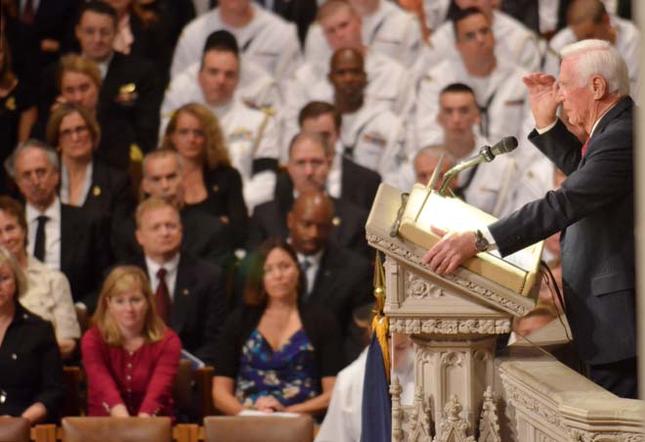
Fellow astronauts, the Armstrong family, members of Congress, government and NASA officials and 1,500 others gathered at the National Cathedral Sept. 13 to pay tribute to Neil Armstrong, the first man to walk on the moon. In tributes, songs and sermon, participants evoked a sense of the man, the engineer, the naval aviator, the Apollo 11 astronaut and the quiet American as reluctant hero who never stopped marveling at space exploration. Armstrong died Aug. 25 at the age of 82. He will be buried at sea tomorrow.
In the front pews were Apollo 11 astronaut Buzz Aldrin, the second man to walk on the moon, with former astronaut and senator, John Glenn, and his wife Annie. Armstrong and Aldrin landed on the moon July 20, 1969.
After the welcome, parts of President John Kennedy’s 1962 speech were played in the cathedral, setting the scene for a flawless, seamless memorial — at once logical and mythopoetic — which spoke as much as about America’s aspirations and achievements as it did about Armstrong. “We choose to go to the moon in this decade and do the other things—not because they are easy, but because they are hard . . .”
Reminding us of the cathedral’s stained-glass Space Window which contains a lunar rock, NASA administrator Charles Bolden, Jr., a former astronaut, said, “Neil Armstrong left more than footprints and a flag on the moon. He left a foundation for the future and paved the way for future American explorers to be the first to step foot on Mars or another planet. Today, let us recommit ourselves to this grand challenge in honor of the man who first demonstrated it was possible to reach new worlds – and whose life demonstrated the quiet resolve and determination that makes every new, more difficult step into space possible.”
Former Secretary of the Navy John Dalton read an apt selection from the Old Testament: the Exodus story of Moses and the burning bush.
Then, another tribute to Armstrong, this one from Apollo 17 astronaut Eugene Cernan, the last man to walk on the moon (at least for now) in December 1972. The thrice space-borne captain said: “In Neil’s mind, it was never about Neil. It was about you, your mothers and fathers, your grandparents, those of an earlier generation, who gave him the opportunity to walk on the moon. . . . He always gave credit to those who just didn’t know it couldn’t be done.”
Cernan recalled a more recent mission he had with Armstrong in Iraq to see the troops, those not yet even born when Americans first landed on the moon. They were enthusiastic to meet Armstrong, Cernan said and added: “They asked him, ‘Why are you here?’ Neil’s honest and thoughtful reply was, ‘Because you are here.’ ”
“He embodied all that is good and all that is great about America,” Cernan continued. “Neil, wherever you are, you again have shown us a way to the stars . . . As you soar through the heavens where even eagles dare not go, you can now truly put out your hand and touch the face of God.” Cernan then saluted his fellow moonwalker.
Next, centered a bit behind the transcept, singer Diana Krall, wearing a moon necklace, sat before a piano and began a slow and spare rendition of “Fly Me to the Moon,” a song played during the Apollo 10 and Apollo 11 missions. Her measured words and notes were stunning.
Friend and former Treasury Secretary John Snow reminded all that Armstrong was “a regular guy” and played golf with the precision of an engineer which he was. Rev. Gina Gilland Campbell then read the Gospel, a selection from Matthew, and the also aptly chosen words of the Sermon on the Mount: “. . . Blessed are the pure in heart, for they will see God. Blessed are the peacemakers, for they will be called children of God. … You are the light of the world. A city built on a hill cannot be hidden.”
The homily was given by the Episcopal Bishop of Washington, the Rt. Rev. Mariann Edgar Budde, who used the story of the rose in the “The Little Prince” to contemplate upon our stewardship of the planet. The rose that one cares for makes it unique beyond the many others. Budde spoke of Armstrong’s concern about international cooperation and the need to save ourselves from ourselves. “The earth was his rose,” she said.
Apollo 11 astronaut Michael Collins then read intercessory prayers: “Bless to us, O God, the moon that is above us, the earth that is beneath us, the friends who are around us, your image deep within us.”
“Creator of the universe, your dominion extends through the immensity of space: guide and guard those who seek to fathom its mysteries. Especially we thank you this day for your servant Neil Armstrong, who with courage and humility first set foot upon the moon. Following his example, save us from arrogance, lest we forget that our achievements are grounded in you; and by the grace of your Holy Spirit, protect our travels beyond the reaches of the earth, that we may glory ever more in the wonder of your creation: through Jesus Christ, your Word, by whom all living things came to be—who with you and the Holy Spirit lives and reigns, one God, for ever and ever.”
Near the end of the service was the singing of “America the Beautiful,” and it soared through the nave by the sounds of the Cathedral Choristers and the U.S. Navy “Sea Chanters.” Our national hymn never sounded better and reminded me of other services here and elsewhere of those lost and those celebrated.
This cathedral on one of the highest points of Washington is central to the ceremonial and spiritual life of this nation. The power of two previous memorial services I attended in this gothic space were remembered: prayers for the crew of Space Shuttle Columbia which annunciated the extraordinary lives of those astronauts and the funeral mass for Katharine Graham whereupon looking for a seat the two nearest ushers guiding us were Bill Gates and Warren Buffet.
As we were dismissed, Bishop Budde blessed the crowd and bid us: “Go forth into the world in peace; search the cosmos, it is the Lord’s; and may the God of all strength nerve you with the courage of the astronauts . . .”
- Apollo 17 commander Gene Cernan gives a heart-felt, powerful tribute to Neil Armstrong. | Patrick G. Ryan
- Nora Birch

